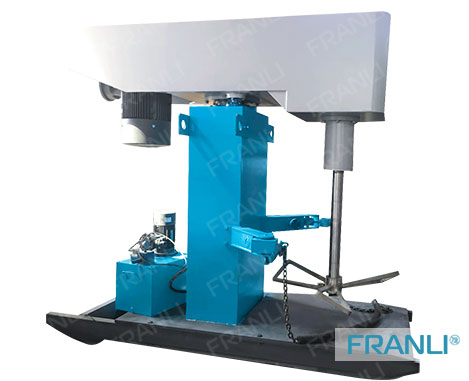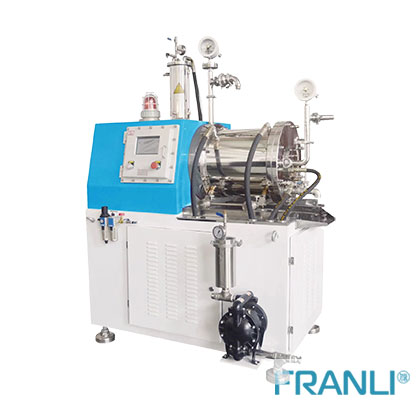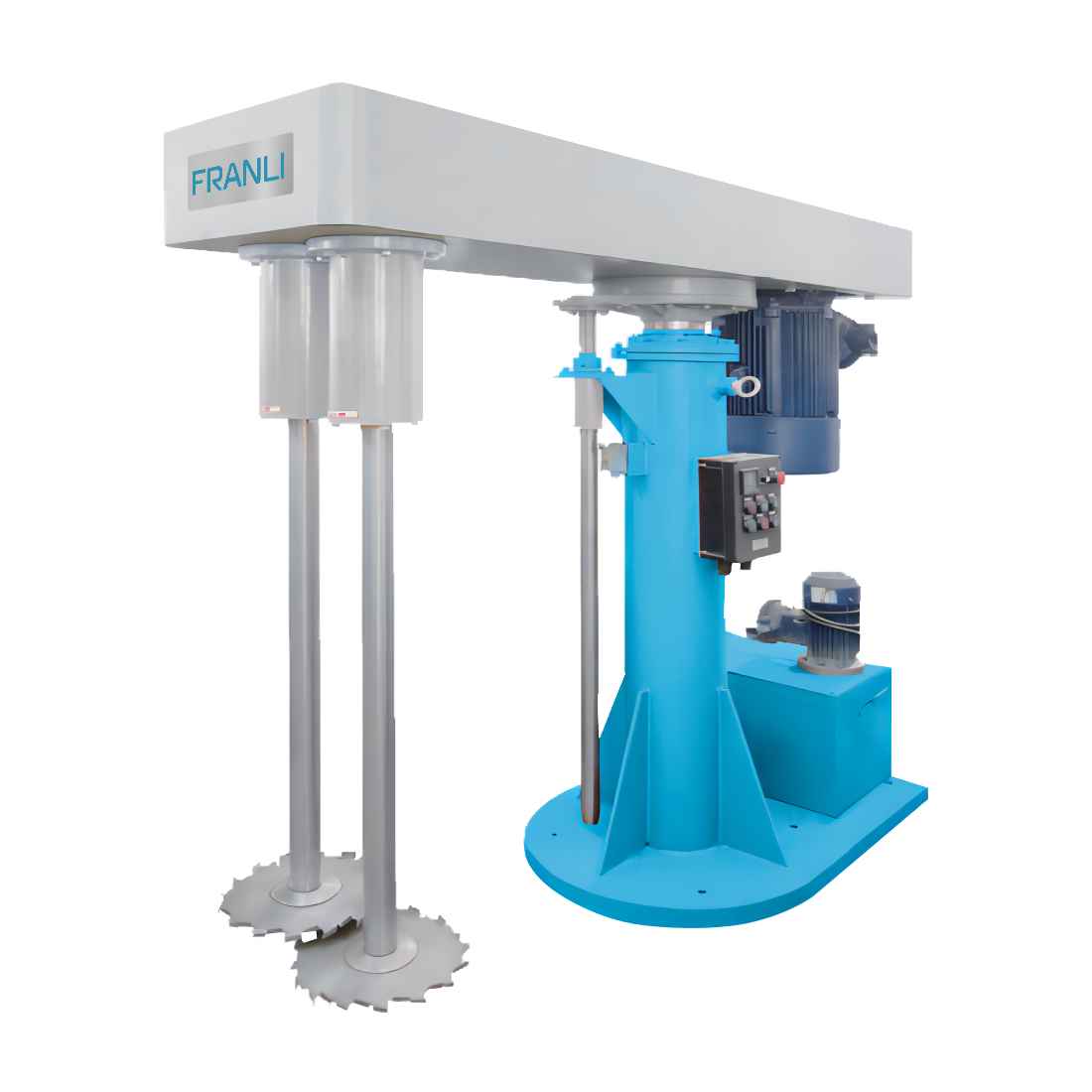Home » Things that must be paid attention to when the three-roll mill is dispersed
Things that must be paid attention to when the three-roll mill is dispersed
The role of premix
The premix of the paint paste is very important, and this is also confirmed theoretically. Because the paint paste is relatively heavy, a more powerful machine is required for mixing. First, add enough paint to wet all the pigments (the ratio is pre-tested or accumulated empirical data) into the mixing tank.
Then add all the pigments, after the stirring is started, the initial wetting begins, and the air is discharged to produce a thick slurry with a strong spherical structure so that a large shear force is generated between the pigment/paint, and stirring until the spherical shape becomes a fluid slurry (It only takes a few minutes), then adjust the viscosity with paint to a viscosity suitable for three-roll mill grinding. It should be a good paint paste with a uniform structure, no lumps of pigment, no air, and no moisture.
Adjustment of roller spacing
The three rollers drive the paint slurry through its two dispersion lines to evenly distribute the pigment particles in the paint. That is the function of dispersing the pigment clusters in the paint paste into fine particles. The completion of this function reflects several comprehensive functions of this machine.
Reasonable use of the two dispersion lines of the three-roll mill, the first dispersion line (feeding groove) is formed between the middle roller and the rear roller, and the second dispersion line is formed between the middle roller and the front roller.
The paint slurry running with the roller passes through the first dispersion line first and then passes through the second dispersion line. The paint slurry on the roller surface is scraped off with a doctor’s blade. It is required to adjust the spacing of the first dispersion line to be greater than the spacing of the second dispersion line. If it is not adjusted in this way, the mechanical function cannot be fully utilized.
Full bucket and more bucket operation
Under normal operating conditions, the distance between the back roll and the middle roll of the three-roll mill is about 51μm, the 325-mesh sieve is 44μm on average, and the pigment is about 0.5% in the 325-mesh sieve. It can be seen that after the pre-mixing of the paint slurry, the larger particles are also within the size range of the roller gap in the rear roller.
First, consider the large particles near the middle roller. Their behavior is to flow in the opposite direction through the center of the roller. Due to the flow of the paint slurry, the large particles are repelled back to the upper part of the feeding ditch, but the small particles near the middle roller are often brought to the feeding gap. In the middle, the small particles continue to pass through, so that 99.5% of the pigment in the paint paste passes through the roller mill.
A well-dispersed paint paste is formed. Large and hard particles remain in the feed ditch. If you continue to grind the hard particles at the tail, not only will it damage the abrasion, but it will also affect the fineness if it is mixed into a large amount of paint slurry.
The operation of the full bucket and the remaining bucket is to leave the remaining 5% of the paint slurry in the feed ditch in the feed ditch for separate collection and processing. To save equipment and time, the dispersion quality can be ensured.
Filtration of impurities
It is difficult to avoid impurities when preparing the paint slurry. If these impurities are not removed, the output of the single machine will be seriously reduced. The function of removing impurities by the three-roll mill is completed between the middle roller surface and the rear roller surface.
When the paint paste is put in, a moving paint paste film is formed at the contact part of the roller surface. The movement direction and fast speed of this moving paint paste film follow the same movement direction as the middle roller surface and the rear roller surface. Speed happened.
However, the moving paint slurry cannot pass the first dispersion line completely, and a part of it is blocked and cannot pass. In this way, the pulling force generated by the different roller speeds agitates the blocked paint slurry, forming the middle roller and the back roller. The reaction force of the paint paste remaining on the top impacts from the bottom to the top, and the function of the three-roll mill to filter out impurities is therefore produced.
The necessity of double-joining
The reaction force of the moving paint slurry produced by the three-roll mill also causes the coarse particles to move to both sides. Because the diameter of the roller is larger in the middle and smaller on the sides, the work done in the middle at the same time is greater than the work done by the sides of the roller, and the reaction force generated in the middle is large, make the coarse particles move to the edge of the roll, and because the distance between the two sides is greater than the middle distance, the middle fineness of the paint slurry on the same roll surface is good, and the fineness on both sides is poor.
The paint paste on both sides must be separated from the paint paste in the middle to avoid confusion between good and bad, to increase the output of a single machine. This is the “double-edge connection” referred to in the three-roll mill operation.
The width of the edge is generally 1/10~2/10 of the length of the roll, and it is different for different pigments, which is determined by the fineness measured at the time. If the roller surface is flattened due to long-term use, this phenomenon will be reduced accordingly. The grinding roller should be repaired.
Reasonable use of scrapers
The scraper is required to scrape off all the paint slurry brought by the front roller as much as possible to increase the output of the single machine.
When choosing a scraper, pay attention to the following points. Straight, thin, hard but not brittle, uniform in texture, and full of elasticity. A suitable scraper is installed on the scraper rack and falls flat on the adjusted roll surface without applying external force. It should be tight and seamless, otherwise, it needs to be replaced.
When the machine is running, the scraper should not be too tight. For example, when the scraper is tightened into a curved shape, the scraping efficiency will be reduced, and the commonly used fixed angle will rub against the roller. Grind the edge of the knife into a bevel.
At this time, the tangent line between the scraper and the roller becomes a wide line. As the contact surface is enlarged, the pressure drops, and the effect of scraping the paint is also reduced. Replace with a new knife. If the scraper is still very straight, it does not need to be replaced, or it can be used the other way around. This is the “reverse scraper” referred to in the three-roll mill operation.
Number of grinding passes
The roll distance is loosened first and then tightened during roll milling. It can be seen from the experiment that there is no change except for particles larger than 60μm after one milling. Therefore, most of the pigments are dispersed on the rolling mill instead of being pulverized.
The dispersing equipment can only de-agglomerate the pigment aggregates and agglomerates, and wet them. It is not suitable to only rely on increasing the pressure between the rollers or reducing the roller distance to pass 1 or 2 passes to achieve the desired grinding fineness.
Copyright Notice :
This article only represents the author’s point of view.
This article is published under the authorization of the author.
Source: Franli
This article address:Things that must be paid attention to when the three-roll mill is dispersed
Related Products

Butterfly Disperser
This kind of butterfly mixer is used in offset ink, putty etc industry. The butterfly dispersing mixer is a product with the functions of dispersing and stirring (wall scraping) developed on the basis of a single-axis hydraulic lifting disperser.

SMP Agitator bead mill
This SMP Agitator bead mill is used in the paint, ink, and coating industries to ready the equal-sized particles of a particular material.

Dispersion Machine
This HSD-D Dispersion Machine with two shafts for mixing and dispersing materials to reach higher efficiency. This machine should be installed jacket tank with a cooling system. The dispersion machine has two shafts working temperature
News
Laboratory Reactor: Guide to Stirring System
The laboratory reactor is composed of a pot body, a pot cover, an agitator, a jacket, a support and transmission device, a shaft seal device, etc.
Grinding Media for Bead Mill | Zirconia Beads & Zirconium Silicate Beads
Bead mills mainly use grinding balls as media, and use impact, extrusion, and friction to achieve the final grinding effect, which mainly depends on the size and hardness of the grinding beads, the filling rate of the grinding beads, and the collision frequency adjustment between the grinding beads and the particles.
Overview of Laboratory Reactor
Laboratory reactors, also known as lab reactors, are essential tools in scientific research, product development, and process optimization. These reactors provide a controlled environment for conducting chemical reactions, mixing, dispersing, and homogenizing processes.
Bead mills | Manufacturing technology in various industries
Bead mills, also known as sand mills or grinding mills, are versatile machines widely used across various industries for the wet grinding and dispersion of solid particles in liquid media.
Ribbon Blender Mixer Equipment
A ribbon blender mixer, also known as a ribbon mixer or horizontal ribbon blender, is a powerful industrial machine designed for thorough and efficient blending of various materials.
What is A Stainless Steel Reactor?
Stainless steel reactors are essential equipment in various industries, including chemical, pharmaceutical, biotechnology, and food processing.
